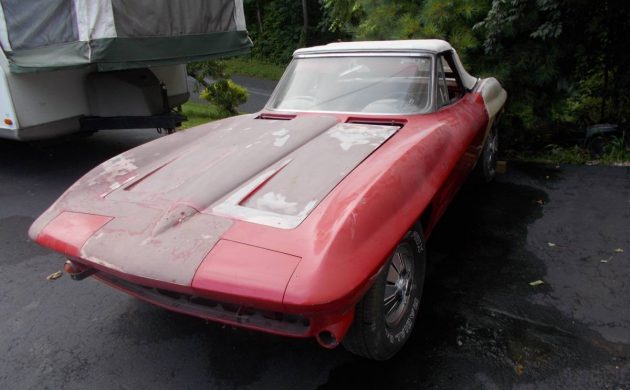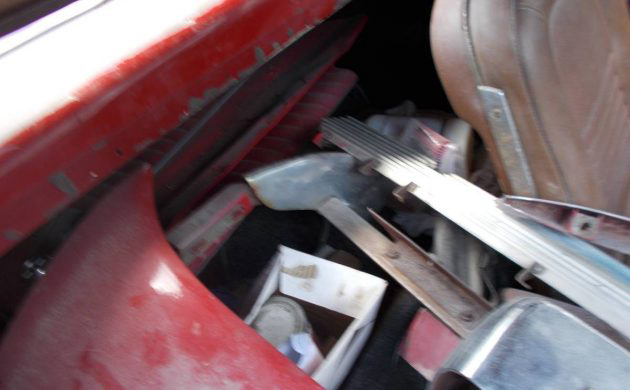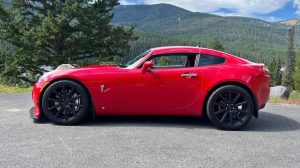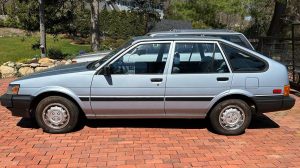We all remember the nursery rhyme “Humpty Dumpty.” Once he took his fall, all the king’s horses and all the king’s men couldn’t put him back together again. Well, I think our faithful reader Levi Andrus has located Old Humpty’s automotive equivalent. Feast your eyes on this 1964 Corvette convertible being sold on craigslist out of Kutztown, Pennsylvania. While the car has definitely seen better days, this haggard ragtop previously hosted one of the most coveted options in the Corvette world: A Rochester Fuel Injection unit. While the ad makes no mention of the whereabouts of the unit now, is a fuelie Corvette worth $26,500 if the fuelie part is AWOL?
1964 was the second year for the new Stingray body style and the last year for drum brakes (except for some 1965s that came with a drum brake substitution credit). It was also the next to last year for Rochester fuel injection. These systems are very different than the electronic fuel injection systems we use today, as they were totally mechanical in operation. These radical fuel systems helped boost engine power and provided immediate response to driver commands. That is, if they were tuned correctly and didn’t have any worn out parts and pieces. Offered on some full sized GM cars from 1957-1959 and on Corvettes from 1957-1965, owners and mechanics often replaced them with a carburetor at the first sign of trouble.
This is one of the reasons why collectors aren’t as crazy about 1964 Vettes as they are the 1963 and 1965 models. 1963 Vettes have the famous split rear window that lasted just one year. They also had a lot of “gingerbread” styling gimmicks that slowly disappeared as time went on. One of these was the fake grills in the hood. They got the ax in 1964, but the indentations in the hood remained. Customers did get the option of knock off wheels in 1964 and some minor changes in the interior. That year saw 22,229 Corvettes built in total. 13,925 were convertibles and only 1,325 cars left the factory with a fuel injected engine.
The photos of the trim tag (above) and the vehicle identification number (in the ad) are blurry and partially undecipherable. From what we can see, the car was built as a convertible and the trim code states that the interior was black and white vinyl. A big plus for the seller is that the car was originally painted Tuxedo Black. Whoever painted the car the current red color must have been an exceptionally thorough person. This car looks like it left the factory as a red car.
You can see evidence of this as you look into the interior. There is red paint under where the sill plates should be, in the hinge area, and it looks like the doors have red paint in the area normally hidden by the door panels. It must have taken a long time to disassemble so much of the car to do such a good job. At any rate, a treasure trove of missing parts are seen inside the car. It would have been nice of the sellers had laid all of these pieces and parts out and taken a few clear pictures of them.
We can also see more parts stretching behind the fawn colored driver’s seat. The two shiny parts we see are the grille and part of the front bumper. Sadly, the trim on the side of the seats looks to have some deep rust pitting. However, the vinyl looks fairly good. A black Corvette convertible would look very good with a fawn colored interior, even if the combination were not original.
Under the hood we see a 327 cubic inch small block V-8 engine with Corvette aluminum valve covers. The seller tells us that this is not the original engine, but the car runs and drives. We can also see that the fuel injection unit is not present either. There is no mention of it coming with the car either. While it is not impossible to find a fuel injection unit, the price for a good one range from $7,000-$10,000. Add to that the cost of a block and accessories, all of which have to have correct date codes, and you can see how it would be an expensive proposition to bring this Corvette up to NCRS Duntov Award standards.
This could be a nice Corvette if you just restored it to be a distinctive driver. Bringing it back to “as-new” condition with all the date correct parts and pieces would take a long time and a lot of folding money. To some Corvette lovers it would be worth it. A fuel injected midyear Corvette convertible is a very nice ride indeed. You’d just have to decide how deep into your pockets you want to reach.
How would you readers handle this one? Full restoration or make a sharp cruiser out of it?


















I’ll be interested to hear what the knowledgeable Corvette fans say about this one.
I know that ordering a factory black exterior/interior and vinyl top (if applicable) on sheet metal cars usually meant the body was straighter, to begin with, but does that apply to fiberglass bodies too?
I hope any prospective buyer gets a clarification on this statement “Most parts go with car” before forking out the cash.
If he still has the Rochester unit, maaaaaybe, but without definitely not.
What he said. If to be turned into a driver, get a Roadstershop frame, add C4 suspension, rebuild the engine, add a Tremec 6 speed, paint it up and go out and drive it.
You’re going to be upside down in this one in short order so buy it to drive, forget it if planning on flipping IMO.
Sorry but this will never be original so build it to enjoy and have fun with it.
1964 is the worse year for the C2 IMO. Not worth near the money w/o the fuel injection unit.
Could I get further explanation on why 64s are less desirable? While I’ve read this a couple of time, I just failed to pick up on what about 64s specifically makes them the lesser C2.
Looks like aftermarket pop rivets on the tags to me, not factory.
Its nothing really against them they just have the lesser desirable drum brakes. Disc brakes were introduced in 1965, along with the availability of the big block engine, which makes the later cars more desirable. The 63 Vettes have the distinction of being the first year C2 and kind of a milestone car largely due to the popularity of the split window styling of the coupes.
This is going to be really tough to come out even close worth the time. I saw a Rochester F/I Unit for a 62 Vette about a year ago, the unit was claimed to rebuilt to brand new condition and they were asking 10k for it. This is a Vette I waoul not want to tackle.
I do’nt think the 64 is less valuable then the 5,6,7 car its in the eye of the beholder,
when you buy a project it going to need replacement parts that the name of the game,know matter you will probably upside down when it done$$$$